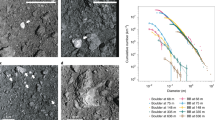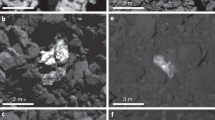Abstract
This paper presents the results that confirm the sublimation activity at the perihelion of the primitive main-belt asteroids 779 Nina, 704 Interamnia, and 145 Adeona; this activity was first discovered in September 2012 (Busarev et al., 2015; Busarev et al., 2016). The new spectrophotometric and/or UBVRI photometric observations of Nina, Interamnia, and Adeona were carried out in 2016–2018 during a regular perihelion passage of these asteroids. Additionally, probable spectral signs of weak sublimation activity were discovered on another two primitive main-belt asteroids, 51 Nemausa and 65 Cybele. In this study, we discuss the conditions for the occurrence of a periodic and/or continuous sublimation process on main-belt asteroids with low-temperature mineralogy; in particular, the conditions that are associated with their formation close to the “snow line” or beyond. We also consider general evolution processes that are able sustain a sufficiently high concentration of water ice close to the surface of the bodies in question and, therefore, their continuous sublimation activity, or lead to the recurrence of extinct activity.








Similar content being viewed by others
REFERENCES
Bakhtin, A.I., Porodoobrazuyushchie silikaty: opticheskie spektry, kristallokhimiya, zakonomernosti okraski, tipomorfizm (Rock-Forming Silicates: Optical Spectra, Crystal Chemistry, Regularities of Coloring, and Typomorphism), Kazan: Kazan. Gos. Univ., 1985.
Bell, J.F., Davis, D.R., Hartmann, W.K., and Gaffey, M.J., Asteroids: the big picture, Proc. Conf. “Asteroids II,” Binzel, R.P., Gehrels, T., and Mattews, M.S., Eds., Tucson: Univ. of Arizona Press, 1989, pp. 98–127.
Broglia, P. and Manara, A., Polarimetric observations of 51 Nemausa during its 1991 apparition, Astron. Astrophys., 1994, vol. 281, pp. 576–578.
Burns, R.G., Mineralogical Applications of Crystal Field Theory, New York: Cambridge Univ. Press, 1993.
Bus, S.J. and Binzel, R.P., Phase II of the small Main-belt asteroid spectroscopic survey. A feature-based taxonomy, Icarus, 2002, vol. 158, pp. 146–177.
Bus, S. and Binzel, R.P., 779 Nina CCD spectrum, in NASA Planetary Data System, Washington, DC: Natl. Aeronaut. Space Admin., 2003a, no. EAR-A-I0028-4-SBN0001/SMASSII-V1.0: 779_01_TAB.
Bus, S. and Binzel, R.P., 704 Interamnia CCD spectrum, in NASA Planetary Data System, Washington, DC: Natl. Aeronaut. Space Admin., 2003b, no. EAR-A-I0028-4-SBN0001/SMASSII-V1.0: 704_01_TAB.
Bus, S. and Binzel, R.P., 145 Adeona CCD spectrum, in NASA Planetary Data System, Washington, DC: Natl. Aeronaut. Space Admin., 2003c, no. EAR-A-I0028-4-SBN0001/SMASSII-V1.0: 145_01_TAB.
Busarev, V.V., Spectrophotometry of atmosphereless celestial bodies of the solar system, Sol. Syst. Res., 1999, vol. 33, no. 2, pp. 120–129.
Busarev, V.V., Spektrofotometriya asteroidov i ee prilozheniya (Spectrophotometry of Asteroids and Its Application), Saarbrucken: LAP LAMBERT Academic, 2011.
Busarev, V.V., A hypothesis on the origin of C-type asteroids and carbonaceous chondrites, Proc. Asteroids, Comets, Meteors Meeting (ACM2012), Niigata, Paris: Eur. Space Agency, 2012, no. 6017. https://arxiv.org/ftp/arxiv/papers/1211/1211.3042.pdf.
Busarev, V.V., Barabanov, S.I., Rusakov, V.S., Puzin, V.B., and Kravtsov, V.V., Spectrophotometry of (32) Pomona, (145) Adeona, (704) Interamnia, (779) Nina, (330825) 2008 XE3, and 2012 QG42 and laboratory study of possible analog samples, Icarus, 2015, vol. 262, pp. 44–57.
Busarev, V.V., Barabanov, S.I., and Puzin, V.B., Material composition assessment and discovering sublimation activity on asteroids 145 Adeona, 704 Interamnia, 779 Nina, and 1474 Beira, Sol. Syst. Res., 2016, vol. 50, no. 4, pp. 281–293.
Busarev, V.V., Makalkin, A.B., Vilas, F., Barabanov, S.I., and Scherbina, M.P., New candidates for active asteroids: Main-belt (145) Adeona, (704) Interamnia, (779) Nina, (1474) Beira, and near-Earth (162,173) Ryugu, Icarus, 2018, vol. 304, pp. 83–94.
Ciarniello, M., De Sanctis, M.C., Ammannito, E., et al., Spectrophotometric properties of dwarf planet Ceres from the VIR spectrometer on board the Dawn mission, Astron. Astrophys., 2017, vol. 598, art. ID A130.
Davidsson, B.J.R., Sierks, H., Guttler, C., et al., The primordial nucleus of comet 67P/Churyumov–Gerasimenko, Astron. Astrophys., 2016, vol. 592, art. ID A63.
Dermott, S.F., Nicholson, P.D., Burns, J.A., and Houck, J.R., Origin of the Solar System dust bands discovered by IRAS, Nature, 1984, vol. 312, pp. 505–509.
Dodd, R.T., Meteorites: A Petrologic, Chemical and Isotopic Synthesis, Cambridge: Cambridge Univ. Press, 1981.
Durda, D.D. and Dermott, S.F., The collisional evolution of the Asteroid belt and its contribution to the zodiacal cloud, Icarus, 1997, vol. 130, pp. 140–164.
Franco, L. and Pilcher, F., Light-curve inversion for 65 Cybele, Minor Planet Bull., 2015, no. 42, pp. 204–206.
Gaffey, M.J., Bell, J.F., and Cruikshank, D.P., Reflectance spectroscopy and asteroid surface mineralogy, Proc. Conf. “Asteroids II,” Binzel, R.P., Gehrels, T., and Mattews, M.S., Eds., Tucson: Univ. of Arizona Press, 1989, pp. 98–127.
Galazutdinov, G.A., A system for processing stellar Echelle spectra. II. Spectra processing, Preprint of the Special Astrophysical Observatory, Russ. Acad. Sci., Nizhnij Arkhyz, 1992, no. 92, pp. 27–52.
Gammelgaard, P., Significant color variation of (51) Nemausa, Proc. 30th Liège International Astrophysical Colloquium, Liège: Univ. Liège Press, 1992, pp. 311–313.
Gopalswamy, N., Yashiro, S., Thakur, N., Mäkelä, P., Xie, H., and Akiyama, S., The 2012 July 23 backside eruption: An extreme energetic particle event? Astrophys. J., 2016, vol. 833, pp. 216–235.
Grün, E., Agarwal, J., Altobelli, N., et al., The 19 Feb. 2016 outburst of Comet 67P/CG: An ESA Rosetta multi-instrument study, Mon. Not. R. Astron. Soc., 2016, vol. 462, suppl. 1, pp. S220–S234.
Guilbert-Lepoutre, A., Besse, S., Mousis, O., Ali-Dib, M., Höfner, S., Koschny, D., and Hager, P., On the evolution of comets, Space Sci. Rev., 2015, vol. 197, pp. 271–296.
Gumerov, R.I., Khamitov, I.M., and Pinigin, G.I., Use of PTT150 telescope in international projects to study the small bodies of the Solar System, Uch. Zap. Kazan. Gos. Univ., Ser. Fiz.-Mat. Nauki, 2013, vol. 155, no. 1, pp. 164–177.
Hansen, J.E. and Travis, L.D., Light scattering in planetary atmosphere, Space Sci. Rev., 1974, vol. 16, pp. 527–610.
Hardorp, J., The Sun among the stars, Astron. Astrophys., 1980, vol. 91, pp. 221–232.
Harris, A.W., Warner, B.D., and Pravec, P., Asteroid lightcurve derived data V13.0, in NASA Planetary Data System, Washington, DC: Natl. Aeronaut. Space Admin., 2012, no. EAR-A-5-DDR-DERIVED-b-V13.0.
Huebner, W.F., Boice, D.C., Reitsema, H.J., Delamere, W.A., and Whipple, F.L., A model for intensity profiles of dust jets near the nucleus of Comet Halley, Icarus, 1988, vol. 76, pp. 78–88.
Jewitt, D., The active asteroids, Astron. J., 2012, vol. 143, pp. 66–80.
Kokhirova, G.I., Ivanova, O.V., Rakhmatullaeva, F.D., Khamroev, U.Kh., Buriev, A.M., and Abdulloev, S.Kh., Results of complex observations of asteroid (596) Scheila at the Sanglokh International Astronomical Observatory, Sol. Syst. Res., 2018, vol. 52, no. 6, pp. 495–504.
Kristensen, L.K., The pole of (51) Nemausa, Astron. Nachr., 1993, vol. 314, pp. 381–390.
Lewis, J.S., The temperature gradient in the solar nebula, Science, 1974, vol. 186, pp. 440–442.
Licandro, J., Campins, H., Kelley, M., Hargrove, K., Pinilla-Alonso, N., Cruikshank, D., Rivkin, A.S., and Emery, J., (65) Cybele: detection of small silicate grains, water-ice, and organics, Astron. Astrophys., 2011, vol. 525, art. ID A34.
Liou, J.-Ch., Zook, H.A., and Jackson, A.A., Radiation pressure, Poynting–Robertson drag, and solar wind drag in the restricted three-body problem, Icarus, 1995, vol. 116, pp. 186–201.
Longhi, J., Phase equilibria in the system CO2–H2O. I. New equilibrium relations at low temperatures, Geochim. Cosmochim. Acta, 2005, vol. 69, pp. 529–539.
Makalkin, A.B. and Dorofeeva, V.A., Temperature distribution in the solar nebula at successive stages of its evolution, Sol. Syst. Res., 2009, vol. 43, no. 6, pp. 508–532.
Masiero, J.R., Grav, T., Mainzer, A.K., Nugent, C.R., Bauer, J.M., Stevenson, R., and Sonnett, S., Main-belt asteroids with WISE/NEOWISE: near-infrared Albedos, Astrophys. J., 2014, vol. 791, art. ID 121.
Müller, T.G. and Blommaert, J.A.D.L., 65 Cybele in the thermal infrared: Multiple observations and thermophysical analysis, Astron. Astrophys., 2004, vol. 418, pp. 347–356.
Nesvorný, D., Vokrouhlický, D., Bottke, W.F., and Sykes, M., Physical properties of asteroid dust bands and their sources, Icarus, 2006, vol. 181, pp. 107–144.
Platonov, A.N., Priroda okraski mineralov (Nature of Color of Minerals), Kiev: Naukova Dumka, 1976.
Reynolds, C.M., Reddy, V., and Gaffey, M.J., Compositional study of 51 Nemausa: a possible carbonaceous chondrite-like asteroid, Proc. 40th Lunar and Planetary Science Conf., Woodlands, 2009, no. 1285.
Safronov, V.S. and Ziglina, I.N., Origin of the asteroid belt, Sol. Syst. Res., 1991, vol. 25, no. 2, pp. 139–146.
Shepard, M.K., et al., A radar survey of M- and X-class asteroids. II. Summary and synthesis, Icarus, 2010, vol. 208, pp. 221–237.
Skorov, Yu.V., Rezac, L., Hartogh, P., Bazilevsky, A.T., and Keller, H.U., A model of short-lived outbursts on the 67P from fractured terrains, Astron. Astrophys., 2016, vol. 593, art. ID A76.
Tedesco, E.F., Noah, P.V., Noah, M., and Price, S.D., IRAS Minor planet survey, in NASA Planetary Data System, Washington, DC: Natl. Aeronaut. Space Admin., 2004, no. IRAS-A-FPA-3-RDR-IMPS-V6.0.
Tholen, D.J., Asteroid taxonomic classifications, Proc. Conf. “Asteroids II,” Binzel, R.P., Gehrels, T., and Mattews, M.S., Eds., Tucson: Univ. of Arizona Press, 1989, pp. 1139–1150.
Warner, B.D., Harris, A.W., and Pravec, P., The asteroid light-curve database, Icarus, 2009, vol. 202, pp. 134–146.
Werner, B., A modest success story: 779 Nina brighter than predicted, Minor Planet Bull., 1991, vol. 18, p. 16.
ACKNOWLEDGMENTS
The authors would like to thank the anonymous reviewers for their helpful comments, which allowed us to considerably improve the description and interpretation of the results.
Funding
The study is funded by the Russian Foundation for Basic Research (project no. 18-02-00105 A). I. Kh., I. B., R. G., E. I., and S. M. would like to thank TÜBİTAK, KFU, AS RT, and SRI for partial support in the use of the RTT150 (Russian–Turkish 1.5-m telescope in Antalya). The study was also funded in part by the subsidy 3.6714.2017/8.9 granted to the Kazan Federal University for performing the state task in the field of scientific activity.
Author information
Authors and Affiliations
Corresponding author
Additional information
Translated by M. Chubarova
Rights and permissions
About this article
Cite this article
Busarev, V.V., Shcherbina, M.P., Barabanov, S.I. et al. Confirmation of the Sublimation Activity of the Primitive Main-Belt Asteroids 779 Nina, 704 Interamnia, and 145 Adeona, as well as its Probable Spectral Signs on 51 Nemausa and 65 Cybele. Sol Syst Res 53, 261–277 (2019). https://doi.org/10.1134/S0038094619040014
Received:
Revised:
Accepted:
Published:
Issue Date:
DOI: https://doi.org/10.1134/S0038094619040014




